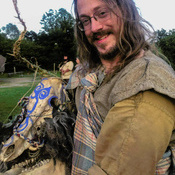Hanging out in Hillforts
Hidden away in the northern corner of Pembrokeshire, is a hillfort – Castell Henllys. The hilltop settlement is archaeologically unique. Visit the site today, and rather than seeing the rounded lumps and bumps associated with roundhouse remains, you will instead see a series of reconstructed roundhouses. They tower up over what remains of the Iron Age ramparts, but, unlike many constructed modern roundhouses, these buildings sit in the footprint of the Iron Age homes.
Over thirty years, Castell Henllys was essentially fully excavated, giving us an amazing insight and understanding of the settlement, but also destroying all of the archaeology. As a result, reconstructing the roundhouses inside the actual fort, causes no further damage. Today, the site is a tourist attraction and an experimental archaeological site. It’s also my second home/job when I’m not working with the Council for British Archaeology.
I’ve had the pleasure of working at Castell Henllys for the last four years. It was a great way for me to stay connected to archaeology, while I started another job in the museums sector (I was working with planes…there was less archaeology involved), and made peace with the fact that my knee joints were not going to tolerate another full season in the field excavating.
So now, instead of trowel and sieve, I spend a lot of my time approaching archaeology with an Iron Age costume on, sword in hand and, on special occasions, a hat made out of a wild boar’s skull carefully balanced on my head. I work a lot with school groups, and a big part of what we do on the site is introduce younger groups to the ideas of Iron Age archaeology. It’s an interesting challenge – it can be difficult releasing young people of their preconceptions; that ‘Celtic’ life was barbarous and savage, defined by shedding blood and battering Romans (and yes, okay, my tendency to swing a sword on almost any occasion probably doesn’t help), but challenging those ideas is what we try to do.
While I’m at Castell Henllys during the Festival of Archaeology, I will mostly be leading workshops introducing experimental ways of building roundhouses, and exploring the role and importance of storytelling in societies with no written culture. These activities, among others, allow us to give a depth of appreciation and understanding for the Iron Age which goes far beyond what a visit to a partially, or totally unexcavated Iron Age settlement, can afford.
Outside of experimental elements and schools, a lot of what the day involves falls into two spheres – speaking with the public about the archaeology of the site, and maintenance. Spending a lot of time in an experimental Iron Age village teaches you a range of things, but mostly it affords a reminder that there is very rarely nothing to do in such a community, even if that amounts to nothing more than an afternoon processing firewood – all of these fairly menial tasks all contribute to a sustainable living experience within the settlement.
Consistently though, a day at Castell Henllys will end with several of us sat by the fire, tired, and chatting. More than once have we remarked that that power down part of the day, slumping by a warm flame, doing next to nothing after a hard day’s work, is probably the most ‘Iron Age thing’ that we do.
A day at Castell Henllys is definitely not among the most conventional days in archaeology, but what it gives us working there, is an insight into how an Iron Age world ‘could’ work. These insights are invaluable and certainly strengthen my appreciation of the possibilities of Iron Age life. It's also a pretty fun environment to hang out in as well!


